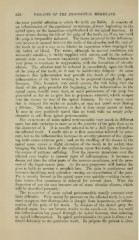Page 914 - My FlipBook
P. 914
924 DISEASES OF THE PERIDENTAL MEMBRANE.
the most painful affection to which the teeth are liable. It consists of
an inflammation of the peridental membrane, always beginning in the
apical space, in the immediate neighborhood of the apical foramen. It
never occurs during the life of the pulp of the tooth, or, if so, not until
the pulp is irreparably inflamed. The tissue involved in the inflamma-
torv process is encased between the walls of the alveolus and the root of
the tooth in such a way as to hinder its expansion when engorged by
the influx of blood. The tissue, although in normal conditions not
unusually sensitive, is richly supplied with nerves, and in the inflam-
matory state soon becomes exquisitely painful. This inflammation is
very prone to terminate in suppuration, with the formation of alveolar
abscess. The affection may be ushered in inmiediately upon the death
of the pulp of the tooth, or it may be indefinitely delayed. In some
instances this inflammation may precede the death of the pulp, the
inflanunation of the latter seeming to be projected through the apical
foramen. This, however, very rarely occurs, the rule being that the
death of the pulp precedes the beginning of the inflammation in the
apical space, usually some days, or until putrescence of the pulp has
proceeded so far as to give rise to poisonous material, which escapes
into the tissues by way of the apical foramen. In very many cases
this is delayed for weeks or months, or may not occur even during
a lifetime. Tlie rule, however, is that it does occur sooner or later.
It may be very positively stated that no tooth with an empty pulp-
chamber is safe from apical pericementitis.
The SYMPTOMS of acute apical pericementitis vary much in different
cases, but this variation is more as to the severity of the pain than as to
the character of it. It is usually ushered in by a dull pain referred to
the affected tooth. Usually this is at first somewhat relieved by pres-
sure, but as the inflammation increases in severity pressure of the oppos-
ing teeth causes extreme pain ; and, as the swelling of the tissues in the
apical space causes a slight elevation of the tooth in its socket, thus
bringing the whole force of the occlusion upon this tooth, this becomes
the source of extreme suffering. Now the mucous membrane over the
affected root begins to present signs of inflammation ; it becomes a
deeper red than the other parts of the mucous membrane, and the pres-
sure of the finger causes pain. As the case progresses still farther the
gum is liable to assume a purplish hue. The pain is continuous and
becomes throbbing, each pulsation causing an exacerbation of the pain.
Pus is usually formed in the apical space very quickly—within twenty-
four hours—but sometimes is delayed for several days. With the
formation of pus the case becomes one of acute alveolar abscess, which
will be described presently.
The DIAGNOSIS of acute apical pericementitis usually presents very
little difficulty. Pain caused by pressure on the affected tooth is a con-
stant symptom that distinguishes it sharply from hypersemia, or inflam-
mation of tlie ])ulp of the tooth. In diseases of the dental pulp the
affected organ does not become tender to the touch—at least, not until
the inflammation has passed through the apical foramen, thus ushering
in ajiical inflammation. In apical pericementitis the pain is always re-
ferred definitely to the particular tooth. In pulpitis the patient is often


